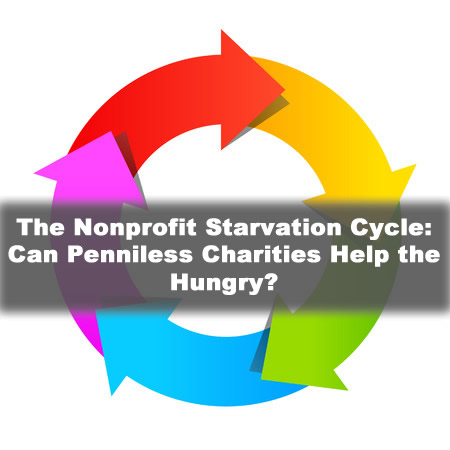The nonprofit starvation cycle is a grim truth, the not-so-hidden, murky underbelly of the social benefit sector. The sad reality is the majority of nonprofit organizations are trapped in a vicious progression of inadequacy and chronic under-funding.
This toxic cycle has been the omnipresent, dark cloud on the nonprofit horizon. With funders, donors and grantees feeling the impact of the last recession, the nonprofit starvation cycle was the elephant in the room no one wanted to acknowledge. All that began to change when the Stanford Social Innovation Review (SSIR) published a ground-breaking essay in 2009 that fired the first volley in the ongoing battle against this insidious phenomenon.
What Exactly is the Nonprofit Starvation Cycle?
The problem has its roots in the erroneous idea that nonprofits should run on good intentions, the sweat of volunteers and little else. Traditionally, the gold standard for measuring a charity’s performance has been low overheads with an “acceptable” proportion falling somewhere around ten to eighteen percent.
Many donors continue to specify that their contributions must go directly to the beneficiaries and not to “overhead” costs. Because these “overheads” or so-called “indirect” expenses are vital to fully support the mission, nonprofits tend to be chronically underfunded. Charities are under pressure to work for as little as possible and their staff even more so.
Cause and Effect
Simply put, this is how the nonprofit starvation cycle plays out:
- Funders and donors harbor unrealistic ideas about the cost of running a nonprofit.
- Nonprofits feel pressure to bend to the donors’ idealistic expectations
- Nonprofits react by spending too little on overhead and minimizing outlays on tax forms and in fundraising materials
- Under-spending and understating continues to feed unrealistic expectations from funders and donors.
- Over time, nonprofits are expected to accomplish more and more with a dwindling pool of resources – a cycle resulting in nonprofit starvation.
According to one industry insider, his experience as a grant maker has only served to confirm the extent of the problem and the subtleties underpinning the starvation cycle.
Debunking the Overhead Myth
The crux of the matter lies in a factor known as the overhead myth. This vague notion posits that salaries shouldn’t be too high and overheads must be low or preferably nonexistent. Charity workers don’t need proper compensation; the warm and fuzzy feelings engendered by good works will more than compensate for the low pay, long hours and resultant burnout, bedeviling sector staff.
If unrealistic expectations on the part of funders and donors are the starting point, nonprofit leaders add further fuel to the fire by dissembling on the issue of overhead. It’s a fact that charities are held to a “higher” standard than other businesses and not only by funders. Often, it is nonprofit pros holding themselves and their organizations to this unworkable benchmark.
Who Suffers?
The myth of low overhead has been around so long that it has become entwined in the very fiber and culture surrounding nonprofits. Many industry professionals while laboring under it, are unwittingly perpetuating this fantasy and don’t realize how the ethos holds the entire sector to ransom.
Ironically, the charities – and their beneficiaries – who can least afford these enforced frugalities suffer most from the flawed standards.
- Small nonprofits and local charities have little or no access to the economies of scale available to larger organizations
- New nonprofits, just setting up shop, have higher expenses and overheads compared to established organizations
- Organizations delivering services to beneficiaries, with inadequate or useless furniture and equipment
- Nonprofits that struggle with non-functioning computers and other essential tools
Charities need freedom to deliver the services they provide in the best and most efficient way. Putting the emphasis on overhead, effectively sentences the organization to hard labor in unfavorable conditions. Why then, do so many donors and funders insist on their contribution going to aid beneficiaries directly and not to the organization that provides that aid?
Responsible Funders and Donors
The conversation surrounding the nonprofit starvation cycle and the overhead myth is now out in the open with some funders beginning to challenge the status quo.
One major foundation has stepped up to the plate by doubling its overhead rate to 20 percent as of January 2016. Other funders are beginning to see the necessity of a strong technology foundation as an essential element for effective nonprofits.
>> Funders need to pay their grantees what it takes to get the job done. Emphasis needs to shift from funding individual programs to building strong organizations, capable of accomplishing real change.
>> Donors and funders need to understand that poor pay, no development budget, no training and outdated equipment hamstrings an organization’s ability to help the communities it is trying to serve.
(Read more about fundraising letters.)
Responsible Nonprofits
Some nonprofits are able to cover their overhead costs with private funding but this can’t be a solution for every organization. While creating a divide between direct and indirect outlays may work for a large, well-funded nonprofit, smaller charities, without private backing, don’t have the option.
With limited funding dollars available, is it really fair to set a standard that adds to the negative public image of nonprofits’ financial competence and mission impact? Charities need to stop working against each other and presenting unrealistic facades while trying to impress donors.
Change Is in the Air
The nonprofit sector needs more transparency, better communication and a new understanding of the concept of direct costs versus indirect costs. Organizations need to gain donors’ confidence by demonstrating how multifaceted and complex their work is. One way is by tracking metrics that effectively demonstrate a charity’s impact and communicating the results to their donors and funders.
The nonprofit starvation cycle would cease to exist if funders, donors and charities engaged in more straightforward dialogue about the actual operating costs of nonprofit organizations.

